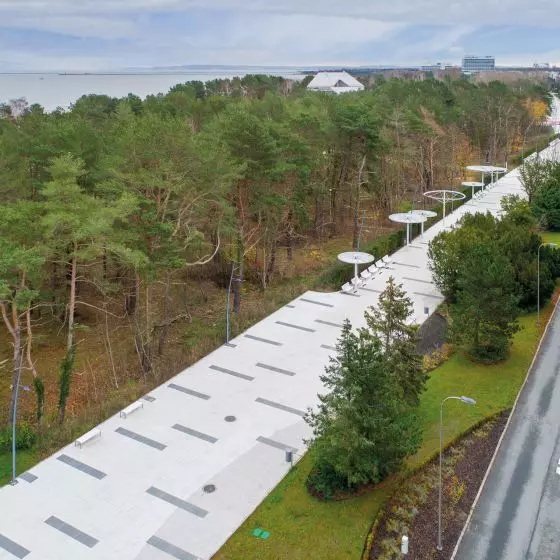A modern, energy-efficient inclusive kindergarten has been built in Opole 's Malinka neighborhood. Clear, inclusive and adapted to the needs of preschoolers, the building along with its surroundings (playgrounds and greenery) is a project by Andrzej and Malgorzata Zatwarnicki of Architop studio.
Consisting of five branches, Kindergarten No. 63 in Opole, located on Tarnopolska Street, is a simple, one-story building designed for more than a hundred preschoolers. Thanks to an intuitive division of functions and interiors, its users easily find their way around the space. The architects also focused on energy efficiency and ecological solutions—using natural insolation and energy recovery from the ground.
Each of the kindergarten rooms has its own terrace
Photo: Andrzej Zatwarnicki © Architop
interview with Andrzej and Malgorzata Zatwarnicki
Dobrawa Bies: Designing public buildings—education, or kindergartens is definitely different from private investments. What requirements / guidelines of the investor did you have to face?
Andrzej and Malgorzata Zatwarnicki: Educational facilities have a specific task to fulfill. A kindergarten or school facility is a tool for accomplishing it. It must be simple, friendly and enable effective educational and upbringing activities. This is where our future is shaped—the next young generation. The space should be legible, adapted to the scale of the user, resistant to long-term intensive use. Aesthetic, legible, clear and simple form is important. The environment, its aesthetic level is also an educational element. All this affects us, builds our identity, value and promotes integration. In addition, and this is especially important today, such facilities must be energy efficient and preferably self-sufficient when it comes to heating. Eco-friendly—ours uses its own rainwater to water the garden. These factors are the basic requirements and at the same time the investor's guidelines.
Color accents appear on the facade and in the surroundings of the kindergarten
Photo: Andrzej Zatwarnicki © Architop
Dobrawa: The kindergarten has a simple one-story body with a light-colored facade, partially covered with boards. You have also used color accents. What is the reason for such a solid appearance?
Andrzej and Malgorzata Zatwarnicki: We prefer simple, uncluttered forms. The compact body allows for a high degree of energy efficiency. Communication in such a building is very simple and clear. There are no questions—and where is this or that. Everything is immediately clear. Color accents? This is a kindergarten, a little stimulation of the senses must be. This is the case outside. The interiors are calm and subdued, without overstimulation. Properly selected and dosed games, toys and games are an integral part of the premise.
The kindergarten has a simple division
© Architop
Dobrawa: What spaces have been created in the new kindergarten and how are they adapted to children? What in particular did you put emphasis on during the design work?
Andrzej and Malgorzata Zatwarnicki: The kindergarten consists of five integrated units consisting of: a play and rest room, sanitary and auxiliary rooms. The classrooms are equipped with modern multimedia educational tools. They all have exits to the garden, each with its own terrace and sun canopy. The seasons come into their own. A multi-purpose activity room with a mini-functional-scenery was located at the main entrance for special events and performances. The room has access from the entrance hall for children and parents. During special events, we do not cross the movement of performers—spectators. The organization of interiors and communication is oriented towards contact between teachers and caregivers. The communication axis is complemented by an interior greenbelt run in the floor. The facility has small multimedia classrooms for dedicated activities—compensatory classes/languages/speech therapy, for small group work. It is an inclusive kindergarten. It provides an opportunity to level the playing field. It is, of course, fully inclusive for people with disabilities. Integration is supposed to take place in an unobtrusive way. There are no barriers for anyone.
On the patios there are lockers for equipment and toys
Photo: Andrzej Zatwarnicki © Architop
Dobrawa: How was the immediate surroundings of the kindergarten solved?
Andrzej and Malgorzata Zatwarnicki: The zone in front of the entrance is public and unfenced. The children's zone-enclosed by a fence and greenery-has shaded outdoor patios for learning and play with outdoor storage for equipment and toys, an outdoor stage with a small auditorium. The younger children's wing is connected to a playground dedicated to them, and the older children's wing is connected to an opening to a play area dedicated to them, as well as a zone for quiet and group games. There are seats for caregivers, from where the whole area and all the little ones can be observed and controlled. There is a mini hill for improving children's motor skills, lots of greenery. Plants have a function that is not only decorative—they introduce the right microclimate, shade part of the playground. Thanks to large glazing, greenery is present in the building, changes the character of the space with the passing seasons and provides insulation from the road.
The architects tried to create a simple and friendly form
Photo: Andrzej Zatwarnicki © Architop
Dobrawa: What was the biggest design challenge, and what are you most proud of?
Andrzej and Malgorzata Zatwarnicki: Such a challenge is always to create a maximally simple, clear, yet functional structure with dressing it in a light and friendly form. Creating harmony between the elements of the building so that people feel comfortable inside and outside. The building uses an advanced heat recovery ventilation system with a cooling function and is not energy-intensive air conditioning, but energy recovery from the ground. Heat pumps are powered with photovoltaics—coordinating and hiding these systems is not easy.
Dobrawa: Thank you for the interview.


















































